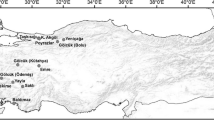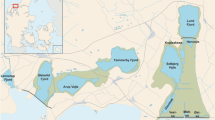Abstract
Climate models predict an increasing frequency of extremely hot summer events in the northern hemisphere for the near future. We hypothesised that microbial grazing by the metazoan macrofauna is an interaction that becomes unbalanced at high temperatures due to the different development of the grazing rates of the metazoans and the growth rates of the microbial community with increasing temperature. In order to test this hypothesis, we performed grazing experiments in which we measured the impact of increasing temperatures on the development of the grazing rates of riverine mussels in relation to the growth rates of a unicellular prey community (a natural heterotrophic flagellate community from a large river). In a first experimental series using Corbicula fluminea as a grazer and under the addition of a carbon source (yeast extract), the increase of the prey’s growth rates was considerably stronger than that of the predator’s grazing rates when temperatures were increased from 19 to over 25°C. This was also the outcome when the mussels had been acclimatized to warm temperatures. Hereafter, specific experiments with natural river water at temperatures of 25 and 30°C were performed. Again, a strong decrease of the mussels’ grazing rates in relation to the flagellate growth rates with increasing temperature occurred for two mussel species (C. fluminea and Dreissena polymorpha). When performing the same experiment using a benthic microbial predator community (biofilms dominated by ciliates) instead of the benthic mussels, an increase of the grazing rates relative to the growth rates with temperature could be observed. Our data suggest that predator–prey interactions (between metazoans and microbes) that are balanced at moderate temperatures could become unbalanced at high temperatures. This could have significant effects on the structure and function of microbial communities in light of the predicted increasing frequency of summer heat waves.



Similar content being viewed by others
References
Aldridge DW, Payne BS, Miller AC (1995) Oxygen consumption, nitrogenous excretion, and filtration rates of Dreissena polymorpha at acclimation temperatures between 20 and 32°C. Can J Fish Aquat Sci 52:1761–1767
Ansell AD, Sivadas P (1973) Some effects of temperature and starvation on the bivalve Donax vittatus (da Costa) in experimental laboratory populations. J Exp Mar Biol Ecol 13:229–262
Arndt H, Dietrich D, Auer B, Cleven EJ, Gräfenhan T, Weitere M, Mylnikov AP (2000) Functional diversity of heterotrophic flagellates in aquatic ecosystems. In: Leadbeater BSC, Green JC (eds) The flagellates. Taylor & Francis, London, pp 240–268
Azam F, Fenchel T, Field JG, Gray JS, Mayer-Reil LA, Thingstad F (1983) The ecological role of water-column microbes in the sea. Mar Ecol Prog Ser 10:257–263
Barbanera F, Erra F, Banchetti R (2002) Not-adaptive behaviour of isotropically heated, inert populations of Oxytricha bifaria (Ciliophora, Stichotrichia). J Eukaryot Microbiol 49:54–62
Baumgartner M, Yapi A, Gröbner-Ferreira R, Stetter KO (2003) Cultivation and properties of Echinamoeba thermarum n. sp., an extremely thermophilic amoeba thriving in hot springs. Extremophiles 7:267–274
Bonkowski M, Cheng W, Griffiths B, Alphei J, Scheu S (2000) Microbial–faunal interactions in the rhizosphere and effects on plant growth. Eur J Soil Biol 36:135–147
Both C, Visser ME (2001) Adjustment to climate change is constrained by arrival date in a long-distance migrant bird. Nature 41:296–298
Brown JH, Valone TJ, Curtin CG (1997) Reorganization of an arid ecosystem in response to recent climate change. Proc Nat Acad Sci USA 94:9729–9733
Caraco NF, Cole JJ, Raymond PA, Strayer DL, Pace ML, Findlay SEG, Fischer DT (1997) Zebra mussel invasion in a large, turbid river: phytoplankton response to increased grazing. Ecology 78:588–602
Charlier D, Droogmans L (2005) Microbial life at high temperature, the challenges, the strategies. Cell Mol Life Sci 62:2974–2984
Cohen RH, Dresler PV, Phlips EJP, Cory RL (1984) The effect of the Asiatic clam, Corbicula fluminea, on phytoplankton of the Potomac River, Maryland. Limnol Oceanogr 29:170–180
Cooper VS, Bennett AF, Lenski RE (2001) Evolution of thermal dependence of growth rate of Escherichia coli populations during 20,000 generations in a constant environment. Evolution 55:889–896
Dorgelo J, Smeenk JW (1988) Contribution to the ecophysiology of Dreissena polymorpha (Pallas) (Mollusca: Bivalvia): growth, filtration rate and respiration. Verh Int Verein Limnol 23:2202–2208
Dukes JS, Mooney HA (1999) Does global change increase the success of biological invaders? Trends Ecol Evol 14:135–139
Durant JM, Hjermann DO, Anker-Nilssen T, Beaugrand G, Mysterud A, Pettorelli N, Stenseth NC (2005) Timing and abundance as key mechanisms affecting trophic interactions in variable environments. Ecol Lett 8:952–958
Gaedke U, Hochstädter S, Straile D (2002) Interplay between energy limitation and nutritional deficiency: empirical data and food web models. Ecol Monogr 72:251–270
IPCC (2001) Third assessment report of the intergovernmental panel on climate change IPCC (WGI & II). Cambridge University Press, Cambridge
Jürgens K, Jeppesen E (2000) The impact of metazooplankton on the structure of the microbial food web in a shallow, hypertrophic lake. J Plankton Res 22:1047–1070
Jürgens K, Wickham SA, Rothhaupt KO, Santer B (1996) Feeding rates of macro- and microzooplankton on heterotrophic nanoflagellates. Limnol Oceanogr 41:1833–1839
Laakso J, Löytynoja K, Kaitala V (2003) Environmental noise and population dynamics of the ciliated protozoa Tetrahymena thermophila in aquatic microcosms. Oikos 102:663–671
Lei L, Payne BS, Wang SY (1996) Filtration dynamics of the zebra mussel Dreissena polymorpha. Can J Fish Aquat Sci 53:29–37
McGowan JA, Cayan DR, Dorman LM (1998) Climate–ocean variability and ecosystem response in the Northeast Pacific. Science 281:210–217
Menzel A, Fabian P (1999) Growing season extended in Europe. Nature 397:659
Montagnes DJS, Franklin DJ (2001) Effect of temperature on diatom volume, growth rate, and carbon and nitrogen content: reconsidering some paradigms. Limnol Oceanogr 46:2008–2018
Montagnes DJS, Kimmance SA, Atkinson D (2003) Using Q10: can growth rates increase linearly with temperature? Aquat Microb Ecol 32:307–313
Norf H, Arndt H, Weitere M (2006) Impact of local temperature increase on the early development of biofilm-associated ciliate communities. Oecologia (in press). DOI 10.1007/s00442-006-0545-6
Parmesan C (1996) Climate and species’ range. Nature 382:765–766
Phelps HL (1994) The Asiatic clam (Corbicula fluminea) invasion and system-level ecological change in the Potomac River estuary near Washington, DC. Estuaries 17:614–621
Pomeroy LR, Wiebe WJ (2001) Temperature and substrate as interactive limiting factors for marine heterotrophic bacteria. Aquat Microb Ecol 23:187–2001
Reeders HH, bij de Vaate A (1990) Zebra mussels (Dreissena polymorpha): a new perspective for water quality management. Hydrobiologia 200/201:437–450
Ricciardi A, MacIsaac HJ (2000) Recent mass invasion of the North American Great Lakes by Ponto–Caspian species. Trends Ecol Evol 15:62–65
Sanford E (1999) Regulation of keystone predation by small changes in ocean temperature. Science 283:2095–2097
Savage VM, Gillooly JF, Brown JH, West GB, Charnov EL (2004) Effects of body size and temperature on population growth. Am Nat 163:429–441
Schär C, Vidale PL, Lüthi D, Frei C, Häberli C, Liniger MA, Appenzeller C (2004) The role of increasing temperature variability in European summer heatwaves. Nature 427:332–336
Scherwass A, Arndt H (2005) Structure, dynamics and control of the ciliate fauna in the potamoplankton of the River Rhine. Arch Hydrobiol 164:287–307
Silverman HS, Achlberger EC, Lynn JW, Dietz TH (1995) Filtration and utilization of laboratory-cultured bacteria by Dreissena polymorpha, Corbicula fluminea and Carunculina texasensis. Biol Bull 189:308–319
Sprung M, Rose U (1988) Influence of food size and food quantity on the feeding of the mussel Dreissena polymorpha. Oecologia 77:526–532
Stachowicz JJ, Terwin JR, Whitlatch RB, Osman RW (2002) Linking climate change and biological invasions: ocean warming facilitates nonindigenous species invasions. Proc Nat Acad Sci USA 99:15497–15500
Staehr PA, Sand-Jensen K (2006) Seasonal changes in temperature and nutrient control of photosynthesis, respiration and growth of natural phytoplankton communities. Freshw Biol 51:249–262
Stauffer D, Arndt H (2005) Simulation and experiment of extinction or adaptation of biological species after temperature changes. Int J Mod Phys C 16:389–392
Stott PA, Stone DA, Allen MR (2004) Human contribution to the European heatwave of 2003. Nature 432:610–614
Strayer DL, Powell J, Ambrose P, Smith LC, Pace ML, Fischer DT (1996) Arrival, spread, and early dynamics of a zebra mussel (Dreissena polymorpha) population in the Hudson River estuary. Can J Fish Aquat Sci 53:1143–1149
Taylor DL, Collie SC (2003) A temperature- and size-dependent model of sand shrimp (Crangon septemspinosa) predation on juvenile winter flounder (Pseudopleuronectes americanus). Can J Fish Aquat Sci 60:1133–1148
Walther GR, Post E, Convey P, Menzel A, Parmesan C, Beebee TJC, Fromentin J-M, Hoegh-Guldberg O, Bairlein F (2002) Ecological responses to recent climate change. Nature 416:389–395
Walz N (1978) The energy balance of the freshwater mussel Dreissena polymorpha Pallas in laboratory experiments and in Lake Constance. I. Pattern of activity, feeding and assimilation efficiency. Arch Hydrobiol Suppl 55:83–105
Way CM, Hornbach DJ, Miller-Way CA, Payne BS, Miller AC (1990) Dynamics of filter feeding in Corbicula fluminea (Bivalvia: Corbiculidae). Can J Zool 68:115–120
Weisse T, Stadler P, Lindström ES, Kimmance SA, Montagnes DJS (2002) Interactive effect of temperature and food concentration on growth rate: a test case using the small freshwater ciliate Urotricha farcta. Limnol Oceanogr 47(5):1447–1455
Weitere M, Arndt H (2002) Top–down effects on pelagic heterotrophic nanoflagellates (HNF) in a large river (River Rhine): do losses to the benthos play a role? Freshw Biol 47:1437–1450
Weitere M, Arndt H (2003) Structure of the heterotrophic flagellate community in the water column of the River Rhine (Germany). Eur J Protistol 39:287–300
Weitere M, Schmidt-Denter K, Arndt H (2003) Laboratory experiments on the impact of biofilms on the plankton of a large river. Freshw Biol 48:1983–1992
Weitere M, Scherwass A, Sieben KT, Arndt H (2005) Planktonic food web structure and potential carbon flow in the lower River Rhine with a focus on the role of the protozoans. River Res Appl 21:535–549
Winder M, Schindler DE (2004) Climate change uncouples trophic interactions in an aquatic ecosystem. Ecology 85:2100–2106
Acknowledgments
This study is part of the priority program “Impact of climate variability on aquatic ecosystems (AQUASHIFT)” funded by the German Research Foundation (DFG). We also thank Andreas Vohmann for sampling C. fluminea and Jost Borcherding for sampling D. polymorpha as well as Fred Bartlett for helpful comments. The experiments comply with the current laws of Germany.
Author information
Authors and Affiliations
Corresponding author
Additional information
Communicated by Ulrich Sommer.
Priority programme of the German Research Foundation—contribution 7.
Rights and permissions
About this article
Cite this article
Viergutz, C., Kathol, M., Norf, H. et al. Control of microbial communities by the macrofauna: a sensitive interaction in the context of extreme summer temperatures?. Oecologia 151, 115–124 (2007). https://doi.org/10.1007/s00442-006-0544-7
Received:
Accepted:
Published:
Issue Date:
DOI: https://doi.org/10.1007/s00442-006-0544-7




